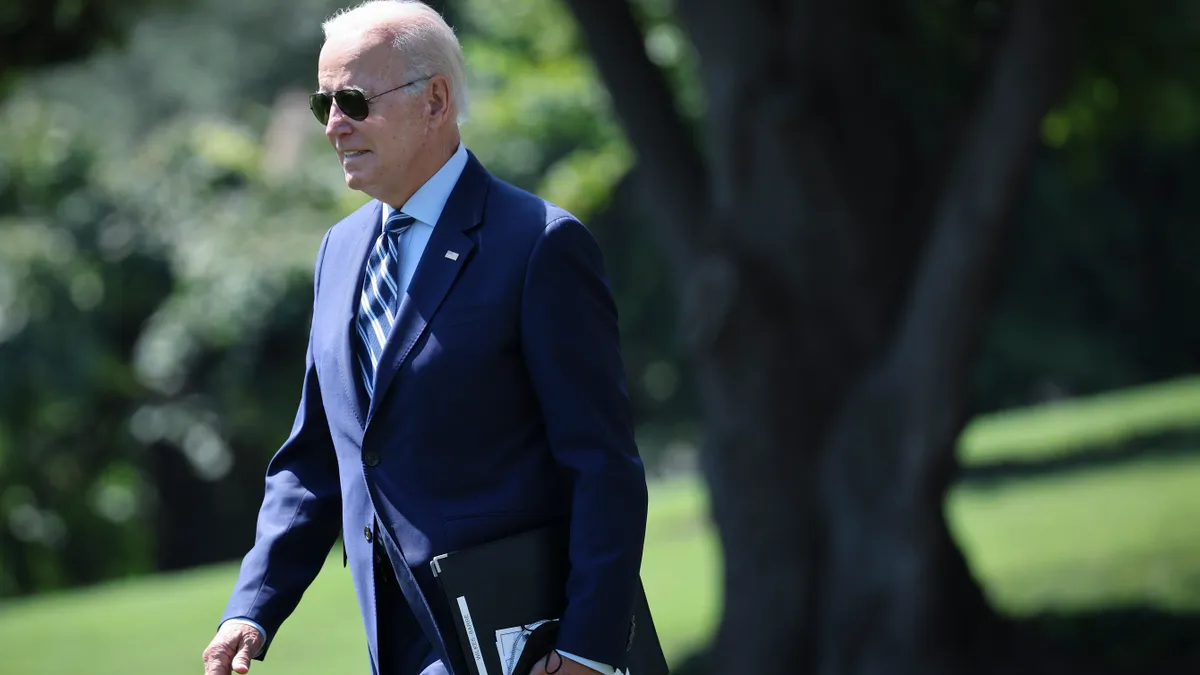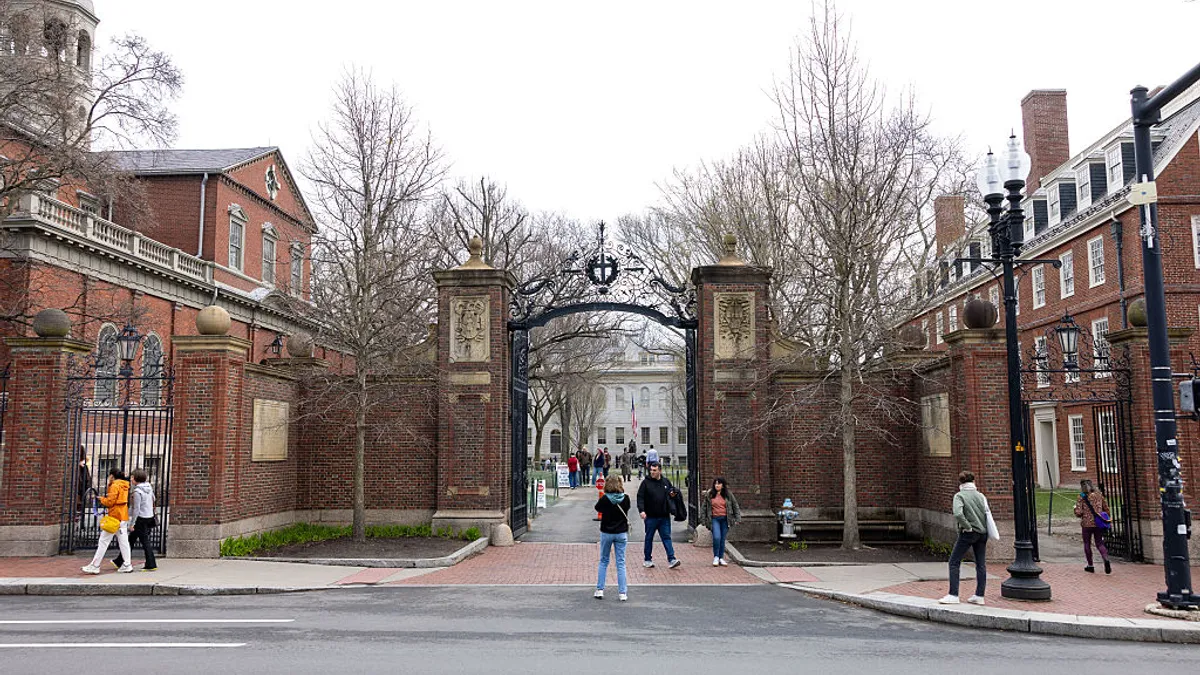Higher education associations have praised President Joe Biden's federal student loan debt cancellation, with caveats: Much more needs to be done. We must act to modernize the federal student loan program. Loan relief without proposals for systemic reform is incomplete.
Biden aimed to fulfill a campaign-trail promise when he announced last week that the federal government will cancel up to $10,000 for individuals earning as much as $125,000 a year and up to $20,000 for those who received federal Pell Grants. His administration also proposed changes designed to make income-based repayment programs — which use borrowers' salaries to determine their monthly payments — more affordable.
Yet as the higher ed associations alluded, Biden took a one-time step. The same student loan system that ultimately pressed the president to issue debt forgiveness remains intact.
That system saw already mountainous federal student loan debt more than triple in a decade and a half to about $1.6 trillion. The number will drop when debts are forgiven, but the question lurks: Are any loan system reforms on the horizon that could prevent the country from ending up back at this same point in the future?
Fixing the system requires wholesale revisions to the law that are likely unachievable in a gridlocked and highly partisan Congress, higher ed experts say. Even federal changes would likely only reach so far, as state policy, colleges' behavior and individual choices also play roles in how much students borrow to go to college.
In the meantime, Biden’s executive action “puts higher education institutions on notice that they have to be leaders to rein in costs,” said Alí Bustamante, deputy director of the Worker Power and Economic Security program at liberal think tank the Roosevelt Institute.
“Many institutions don’t have much of an option,” Bustamante said. “This is an opportunity to think about how they can be proactive and properly identify what cost pressures lead to increased costs of operation.”
What would reforms look like?
Several ideas have been pitched to change the federal financial aid system, or at least hold down the cost of college to students, over the years. Some are more comprehensive than others.
Recently, Democrats have focused on areas including stopping abuses at for-profit colleges, increasing the size of the Pell Grant, and reworks to the current system, such as simplified income-based repayment, better student loan servicing and more debt forgiveness for students whose colleges closed or misled them.
The GOP has floated a legislative alternative to Biden’s executive and regulatory actions. That proposal would cut down on the number of loan repayment plans the U.S. Department of Education could offer, end the troubled Public Service Loan Forgiveness program, and stop the secretary of education from issuing student loan-related regulations that would cost the federal government more money.
In addition, the Republican plan would end a lending program for graduate students that's been criticized for effectively having no limits, add caps to another graduate borrowing program, end interest capitalization, and allow federal Pell Grants to apply toward short-term academic programs.
Others are pushing for cash infusions into the higher ed system.
Tom Harnisch, vice president for government relations at the State Higher Education Executive Officers Association, called for the federal government to incentivize states to channel more money to public colleges. The Education Department could match state appropriations, he said.
Harnisch casts the current situation as the result of decades of public disinvestment from higher education. Although not everyone agrees that's taken place, the argument goes that states often use higher education to balance budgets in lean times. Colleges then must raise tuition to compensate, and education gradually becomes viewed less as a public good — as was the prevailing attitude decades ago — and more as an individual benefit students and families should finance.
“We need to reverse the privatization trend in higher education and show public higher education as a public good,” Harnisch said.
Precedent exists for federal-state partnerships. The former Leveraging Educational Assistance Partnership, or LEAP, initiative, funneled federal grants for need-based aid that states were typically required to match dollar for dollar. It wound down after 2010, with the federal government saying at the time that this type of federal assistance was no longer needed because states had largely developed their own need-based programs.
Constructing a new federal-state partnership is far easier said than done, however.
The federal government’s forays into state policy issues have been historically messy, said Bustamante, of the Roosevelt Institute. The Affordable Care Act's Medicaid expansion ended up before the U.S. Supreme Court, for example, and some conservative states still haven't opted into it.
How realistic are changes?
Biden’s debt forgiveness decision shines a harsh spotlight on the federal loan system. And a recent survey from consultancy EAB listed affordability as parents’ top concern for students entering college, so there is certainly public interest in what happens to that system, especially over the last several years, Harnisch said.
It's a program that features several different repayment plans, often carries high interest rates, and is poorly explained to the general populace, said Terry Hartle, senior vice president of government relations and public affairs at the American Council on Education, higher ed’s top lobbying organization.
The attention on loan cancellation theoretically paves avenues for policymakers across the political spectrum to pursue changes, Hartle said.
“But some days Congress can’t agree the sun will rise in the East tomorrow,” he said.
Congress hasn’t comprehensively rewritten its primary vehicle for postsecondary education policy, the Higher Education Act, since 2008. The last significant attempt to do so stemmed from Sen. Patty Murray, a Democrat and current chair of the Senate’s education committee, and Sen. Lamar Alexander, a Republican and fixture in federal education policy — who retired at the beginning of 2021.
They failed to agree on a final product, even though they were "old-time legislators who wanted to get stuff done,” Hartle said.
“If they couldn’t come to a consensus on a framework that would enable them to draft a bill, it’s hard for me to imagine Congress moving beyond that," Hartle said. "For all intents and purposes, it’s impossible to accomplish.”
Brent Evans, a professor of public policy and higher education at Vanderbilt University, fears Biden's student loan decision could lead to a more toxic outcome than the status quo.
He worries it “poisoned the well” with conservatives, who are rumored to be eyeing lawsuits against Biden, arguing he doesn't have the authority to unilaterally relieve debt. The Biden administration has justified its legal authority under a 2003 law and the coronavirus national emergency.
Beyond the courtroom, critics have argued that broad debt cancellation is a giveaway to colleges and licenses them to hike tuition. Evans doesn’t buy this, as the forgiveness targets past students, and he sees it making little sense for colleges to up their pricing now. Still, negotiating with Republicans over student loan programs could now prove more difficult, Evans said.
“Even some Democrats didn’t agree with passing these monumental changes unilaterally,” he said. “I think the political ramifications will be challenging.”






















